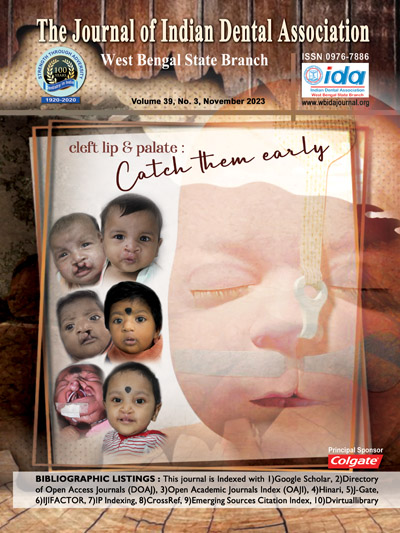Upcoming Events
1. Article Title.
2. Author Details.
3. Abstract.
4. Keywords.
5. Corresponding Author details.
November 2023
Volume : 39
No.: 3

Dr. Muhammed Mahshook AP,Dr. Ankita Das,Dr. Rakesh R.,Prof. (Dr.) Rupa Ghosh,Dr. Ekramur Rahman
Abstract: Maxillary canines are important for esthetic and proper function Orthodontic treatment of impacted maxillary canines is challenging task and necessitate complicated and prolonged treatment. It needs multidisciplinary team including orthodontists, oral surgeons and periodontist. In order to attain better treatment prognosis and stability in management of impacted canines precise application of biomechanics and force levels are essential considerations. This case report describes surgical exposure followed by orthodontic treatment for correction of unilateral maxillary right canine impaction in a 22-year old female patient.
Dr. Manidipa Das,Dr. Sulthana T,Dr. Ankita Das,Dr. Rupa Ghosh,Dr. Soumen Khan
Abstract: After the third molars and the maxillary canines, maxillary central incisors are the third most frequently impacted permanent teeth.Successful treatment outcomes can be determined only through awell-planned and carefully executed orthodontic and surgical treatment.This paper describes a case report of a 14-year-oldmale patient who reported at the Department of Orthodontics of Dr. R Ahmed Dental College & Hospitalwith the chief complaint of a missing upper front tooth. Clinical examination showsa missing maxillary central incisor on the left side with mesially tipped adjacent lateral incisor.The patient was planned to be treated with non-extraction treatment, surgical exposure of the impacted central incisor followed by traction,alignment, and levelling of the arch.
Dr. Mousumi Mondal,Dr. Surbhi Yadav,Dr. Debabrata Sarkar,Dr. Rishi Ray,Dr. Palak Khanna
Abstract: Resorption of alveolar bone height and width following extraction of tooth exert adifficulty in implant placementas it interferes with optimal implant positioning and its overall aesthetic outcomes as well. The resorption of the alveolar ridge is more pronounced on the buccal than on the lingual aspect of the extraction socket. To overcome this complication, a minimally invasive procedure socket shield techniquewas introduced in 2010 by Hurzeler et al. In this clinical procedure, a partial buccal root fragment was retained around an immediately placed implant with the aim of avoiding both hard and soft tissue alterations after tooth extraction. Histologic evaluation in a beagle dog showed no resorption of the root fragment and new cementum formed on the implant surface. Therefore, SST prevents alveolar ridge resorption and achieves tissue preservation. Some Clinical studies suggested thatretaining of buccal aspect of the root during implant placement does not interfere with osseointegration and a maximum amount of horizontal resorption at the buccal side was 0.72mm.
Dr. Nimmisree PN,Dr. Shrabani Mandal,Dr. Arunava Chatterjee,Dr. Partha Pratim Choudhury,Prof. (Dr.) Amal Kumar Chakrabarti
Abstract: Functional Appliance, both fixed and removable, are used to Promote mandibular development by forward repositioning the mandible in developing Class II malocclusions. It alters the neuromuscular environment and promotes favourable growth of the mandible by condylar adaptation. This is a case report of a successful treatment of growing patient with class II div I malocclusion with Twinblock appliance and fixed orthodontic treatment. Twin-block appliances were used in phase I therapy to move the retrognathic mandible forward. A fixed appliance was used in phase II therapy to achieve arch coordination, correct minor displacement, and finalize occlusion. Post treatment Skeletal Class I relation was attained. Incisors' inclination was improved, and ideal overjet and overbite with bilateral class I molar relationship was achieved. As the mandible advanced, lip competency, facial convexity, and mentolabial sulcus improved.
Dr. Shreya Lakshmi,Dr. Arkajit Goswami,Dr. Md Golam Hasan,Dr. Anwesha Dey,Prof. (Dr.) Amal Kumar Chakrabarti
Abstract: Class III malocclusion with multifactorial etiology manifests with dental or skeletal discrepancies. If severe, could lead to compromised facial esthetics and function, thereby compromising the patient's quality of life. The deleterious effects tend to pile up more in a preadolescent/growing patient hence need timely intervention. Even though the management in the late mixed or early permanent dentition can be successful, good results are generally achieved when done in the deciduous or early mixed dentition The present article describes a case of management of class III malocclusion with anterior crossbite in a 9-year-old boy using a bonded Rapid Maxillary Expansion and petit type facemask appliance, followed by fixed orthodontic therapy. The total treatment duration was 2 years and 2 months.
Dr. Srikrishna Chattaraj,Dr. Ekta Lahoti
Abstract: Class II malocclusions mostly occur due to the underdevelopment of the mandible in most cases. Functional appliances can make significant changes in correcting the position of the mandible. In this case report ,the use of fixed anterior inclined plane appliance has been demonstrated along with fixed orthodontic appliance to decrowd the teeth and correct the mandiblular position simultaneously.
Abstract: Periodontal probe is accepted as the most important and useful diagnostic tool now a days in dentistry to detect presence and severity of different type of periodontal disease .It is also used to locate measure and mark the degree of progress of periodontal pocket; a definitive sign of periodontal disease. Now a days various types of periodontal probes are available worldwide . In this article an effort has been made to find out generation of periodontal probe in terms of their uses, advantage and limitation .












